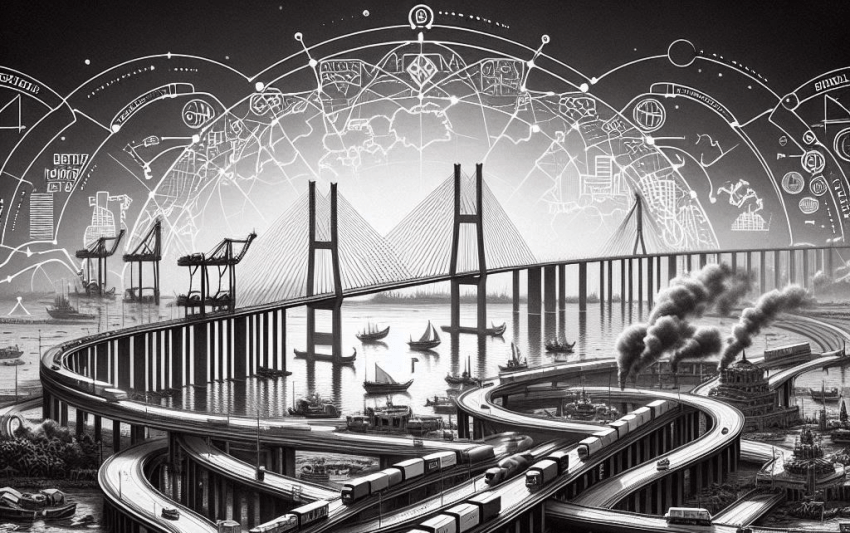On BBIN and other corridors
Projects that connect countries—like the BBIN (Bangladesh, Bhutan, India, Nepal) initiative, BIMSTEC, and transport routes between India and Bangladesh—are really important for building stronger economic and strategic ties in South and Southeast Asia. These efforts aim to make travel and trade easier, promote economic growth, and support peace in the region—especially as China is expanding its own influence through projects like the BCIM (Bangladesh-China-India-Myanmar) corridor.
Strategic Importance
Economic Benefits: These projects help increase trade, with the BBIN MVA potentially boosting regional trade and BIMSTEC projects aiming for major economic growth through better transport. The Indo-Bangla corridors could raise exports by up to 297% for Bangladesh and 172% for India, according to a 2021 World Bank report (Better transport links a win-win for India, Bangladesh: World Bank).
Geopolitical Significance: These projects strengthen India’s relations with its neighbours, reduce China’s influence, and increase India’s role in the Indo-Pacific, aligning with its Act East policy. Improved connectivity also supports regional stability and helps integrate India’s Northeast, which is a key gateway to Southeast Asia.
China’s BCIM vs. India’s Act East
China’s BCIM initiative, which aimed to connect Bangladesh, China, India, and Myanmar to boost trade, was removed from the Belt and Road Initiative (BRI) in 2019 due to India’s concerns over sovereignty, especially related to the China-Pakistan Economic Corridor (CPEC). On the other hand, India’s Act East policy, launched in 2014, focuses on building stronger ties with Southeast Asia through projects like BBIN and BIMSTEC, deliberately avoiding direct Chinese involvement to keep its strategic independence. This contrast shows that while both countries prioritize regional cooperation, India is more focused on securing its sovereignty and security.
Connectivity projects play a key role in regional integration, economic growth, and strategic stability in both South and Southeast Asia. Initiatives like BBIN, BIMSTEC, and Indo-Bangla transport corridors are essential efforts to improve transport links, boost trade, and strengthen geopolitical relationships. This analysis looks closely at these projects, their goals, progress, and strategic importance, while comparing China’s BCIM Economic Corridor with India’s Act East policy.
BBIN Initiative
The BBIN initiative, established in 1996, is a sub-regional cooperation framework that brings together Bangladesh, Bhutan, India, and Nepal to work on areas such as water resources, power connectivity, and transport. It grew out of the South Asian Growth Quadrangle, approved by SAARC in 1996, to promote economic ties within eastern South Asia. One key achievement is the Motor Vehicles Agreement (MVA), signed on June 15, 2015, during a transport ministers’ meeting in Thimphu, Bhutan. The MVA aims to regulate passenger, private, and cargo vehicle traffic to make road transport safer, more efficient, and environmentally friendly.
As of April 2025, progress has been made with Bangladesh, India, and Nepal finalizing the necessary protocols, as reported in a Kathmandu Post article on April 13, 2025. However, Bhutan remains an observer after opting out in 2017 due to environmental concerns, though it continues to participate in discussions without formally joining. The agreement is expected to lower transportation costs and boost trade, especially benefiting India’s Northeast. A study by ICRIER points to potential improvements in export competitiveness for products like pharmaceuticals and fresh pineapples, with suggestions for enhancing inland container depots and logistics systems.
Trade data shows significant potential for growth, with bilateral trade between India and Bangladesh reaching $13 billion in 2023, including $11.3 billion in Indian exports and $1.89 billion in imports. The MVA could further integrate these economies, creating regional supply chains and increasing trade volumes, as noted in an EPW article on the agreement.
BIMSTEC and Transport Connectivity
BIMSTEC, formed in June 1997, includes Bangladesh, Bhutan, India, Myanmar, Nepal, Sri Lanka, and Thailand, and focuses on technical and economic cooperation across various sectors. One of its main priorities is transport connectivity. The 2022 Master Plan for Transport Connectivity, adopted at the fifth BIMSTEC summit, outlines 267 major projects worth $124.4 billion, planned for 2018–2028. The plan, supported by the Asian Development Bank (ADB), covers roads, railways, ports, inland water transport, and aviation, with the goal of linking South and Southeast Asia.

Bengal Initiative for Multi-Sectoral Technical
and Economic Cooperation Road Corridors
Key projects include the India-Myanmar-Thailand Trilateral Highway, which improves road links, and the Kaladan Multi-Modal Transit Transport Project, launched in May 2023, providing road and waterway connections between India’s Northeast and Myanmar. Another important initiative is the coastal shipping service between India and Bangladesh, which began in 2016 and is valued at $81.29 million, including cargo vessels delivered to Myanmar. These projects aim to cut transportation costs, boost trade, and drive economic growth, with over 50% of them having cross-border effects, making it necessary to conduct broader economic analyses for shared benefits.
The economic potential is huge, with BIMSTEC’s combined GDP exceeding $5 trillion and a population of 1.73 billion, which could turn it into a major economic corridor. However, challenges like political instability in Myanmar and funding gaps must be addressed to fully unlock this potential.
Indo-Bangla Transport Corridors
Transport links between India and Bangladesh, which were limited after the 1947 partition, have greatly improved over time. Key connections include the Kolkata-Dhaka bus service (1999), Dhaka-Agartala bus service (2001), and the Maitree Express train, which resumed after a 43-year break. In addition, inland waterways, such as coastal shipping agreements, are helping improve transport, with ongoing projects like the Akhaura-Agartala rail link and upgrades like the Akhaura-Ashuganj route further enhancing connectivity.

In 2023, trade between the two countries reached $13 billion, with India exporting $11.3 billion and importing $1.89 billion, showing a large trade surplus. A 2021 World Bank report indicates that smoother transport links could boost Bangladesh’s exports to India by 297% and India’s exports to Bangladesh by 172%, increasing national incomes by 17% for Bangladesh and 8% for India. These transport corridors are vital for trade in goods like cotton, petroleum, and machinery, strengthening economic ties and regional integration.
Economic and Geopolitical Dimensions
The strategic value of these transport routes is twofold. Economically, they boost trade by lowering logistics costs, with the BBIN MVA helping to streamline transport and BIMSTEC projects aiming for significant growth through better connectivity. The Indo-Bangla corridors have the potential to greatly increase trade volumes, as shown by the projected rise in exports. Geopolitically, these routes strengthen India’s relationships with its neighbors, helping to counter China’s influence by providing alternative connectivity options. For example, BBIN and BIMSTEC are in line with India’s Act East policy, improving its position in the Indo-Pacific and connecting its Northeast, which is a key gateway to Southeast Asia.
These projects contribute to regional stability by encouraging economic interdependence, reducing dependence on external powers like China, and boosting India’s leadership in regional groups. They also address security issues such as counter-terrorism and maritime security, aligning with broader strategic goals.
China’s BCIM vs. India’s Act East
China’s BCIM, proposed in 1999, aimed to link Bangladesh, China, India, and Myanmar with road, rail, water, and air connections, covering 1.65 million square kilometers and serving 440 million people. Initially included in China’s Belt and Road Initiative (BRI) in 2015, it was dropped in 2019 after India pulled out due to concerns over sovereignty, particularly because the China-Pakistan Economic Corridor (CPEC) passes through territory in Pakistan-occupied Kashmir. India’s involvement declined as it raised strategic concerns.
In contrast, India’s Act East policy, launched in 2014, focuses on building economic, strategic, and cultural ties with Southeast Asia through projects like BBIN and BIMSTEC. It prioritizes infrastructure such as the Trilateral Highway and Kaladan project while avoiding direct Chinese involvement to maintain its strategic independence. This comparison shows India’s preference for regional integration that ensures security, in contrast to BCIM’s China-focused approach, which faced geopolitical challenges.

Technical and Economic Cooperation Region
Future Outlook
BBIN, BIMSTEC, and Indo-Bangla transport corridors are key to improving regional connectivity, offering opportunities for economic growth through increased trade and greater strategic stability by boosting India’s role in the region. Despite challenges like funding issues and political instability, these projects have great potential to unite economies and reduce external influence. India’s Act East policy sets it up as a regional leader, in contrast to China’s halted BCIM, pointing to a future of stronger cooperation and strategic alignment in South and Southeast Asia.
———–
Geopolits Research Desk
————–

